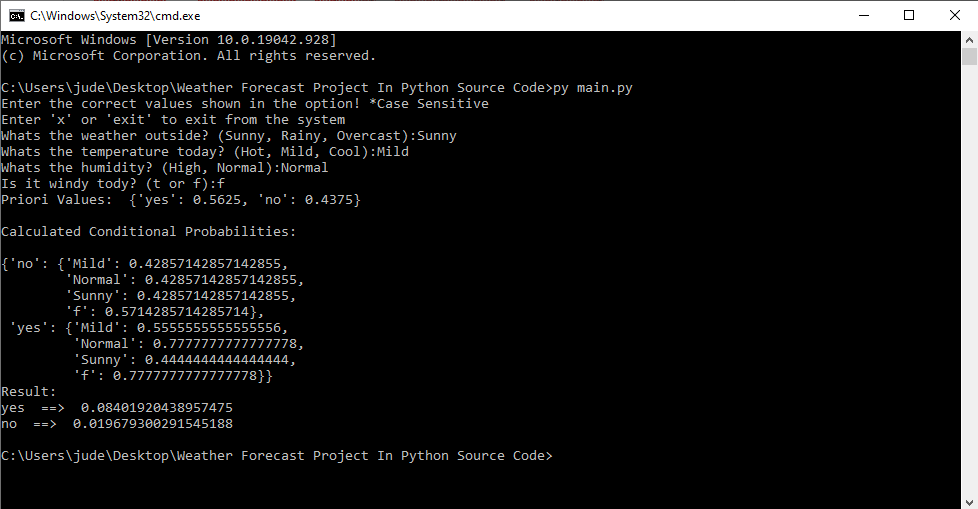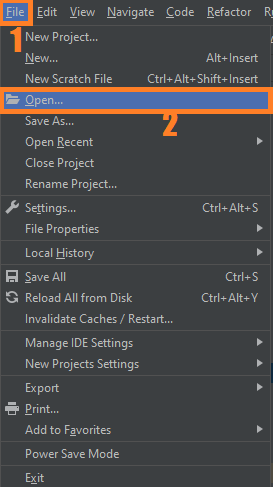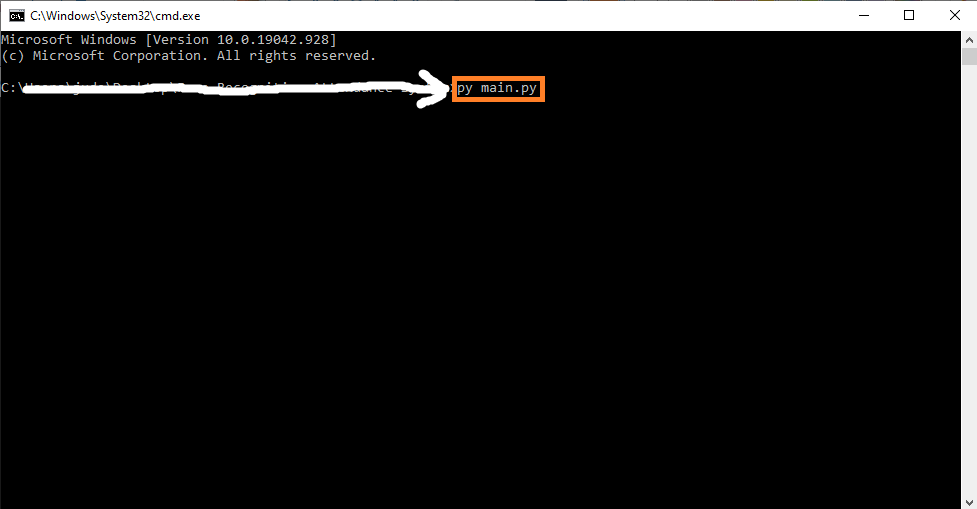Weather Forecast Project In Python With Source Code
The Weather Forecast Project In Python was developed using Python Programming, this Simple Project With Source Code created using console based, and this project is good for the beginners or the students who wants to learn programming specially python programming language.
A Weather Prediction Project In Python is a simple console based application using machine learning which helps to determine if the current situation of weather is good to play or not. It is done under the supervised learning in which data are given first to train the system and then the result for new data will be produce.
This Weather Prediction Python Code also includes a downloadable, Project With Source Code for free, just find the downloadable source code below and click to start downloading.
By the way if you are new to python programming and you don’t know what would be the the Python IDE to use, I have here a list of Best Python IDE for Windows, Linux, Mac OS that will suit for you. I also have here How to Download and Install Latest Version of Python on Windows.
To start executing Weather Forecast Project In Python With Source Code, make sure that you have installed Python 3.9 and PyCharm in your computer.
Weather Forecast Project In Python With Source Code : Steps on how to run the project
Time needed: 5 minutes
These are the steps on how to run Weather Forecast Project In Python With Source Code
- Step 1: Download the given source code below.
First, download the given source code below and unzip the source code.

- Step 2: Import the project to your PyCharm IDE.
Next, import the source code you’ve download to your PyCharm IDE.

- Step 3: Run the project.
last, run the project with the command “py main.py”

Installed Libraries
from functools import reduce import pandas as pd import pprint
Complete Source Code
from functools import reduce
import pandas as pd
import pprint
class Classifier():
data = None
class_attr = None
priori = {}
cp = {}
hypothesis = None
def __init__(self,filename=None, class_attr=None ):
self.data = pd.read_csv(filename, sep=',', header =(0))
self.class_attr = class_attr
'''
probability(class) = How many times it appears in cloumn
__________________________________________
count of all class attribute
'''
def calculate_priori(self):
class_values = list(set(self.data[self.class_attr]))
class_data = list(self.data[self.class_attr])
for i in class_values:
self.priori[i] = class_data.count(i)/float(len(class_data))
print ("Priori Values: ", self.priori)
'''
Here we calculate the individual probabilites
P(outcome|evidence) = P(Likelihood of Evidence) x Prior prob of outcome
___________________________________________
P(Evidence)
'''
def get_cp(self, attr, attr_type, class_value):
data_attr = list(self.data[attr])
class_data = list(self.data[self.class_attr])
total =1
for i in range(0, len(data_attr)):
if class_data[i] == class_value and data_attr[i] == attr_type:
total+=1
return total/float(class_data.count(class_value))
'''
Here we calculate Likelihood of Evidence and multiple all individual probabilities with priori
(Outcome|Multiple Evidence) = P(Evidence1|Outcome) x P(Evidence2|outcome) x ... x P(EvidenceN|outcome) x P(Outcome)
scaled by P(Multiple Evidence)
'''
def calculate_conditional_probabilities(self, hypothesis):
for i in self.priori:
self.cp[i] = {}
for j in hypothesis:
self.cp[i].update({ hypothesis[j]: self.get_cp(j, hypothesis[j], i)})
print ("\nCalculated Conditional Probabilities: \n")
pprint.pprint(self.cp)
def classify(self):
print ("Result: ")
for i in self.cp:
print (i, " ==> ", reduce(lambda x, y: x*y, self.cp[i].values())*self.priori[i])
''' Exit from the system it the input is "x" or "exit" '''
def exitSystem():
print("System Terminated!")
print("Thank you for using this system!")
exit()
if __name__ == "__main__":
c = Classifier(filename="dataset.csv", class_attr="Play")
print("Enter the correct values shown in the option! *Case Sensitive")
print("Enter 'x' or 'exit' to exit from the system")
outlook = input("Whats the weather outside? (Sunny, Rainy, Overcast):")
if outlook.lower() == 'x' or outlook.lower() == 'exit':
exitSystem()
temp = input("Whats the temperature today? (Hot, Mild, Cool):")
if temp.lower() == 'x' or temp.lower()== 'exit':
exitSystem()
humidity = input("Whats the humidity? (High, Normal):")
if humidity.lower() == 'x' or humidity.lower()== 'exit':
exitSystem()
windy = input("Is it windy tody? (t or f):")
if windy.lower() == 'x' or windy.lower()== 'exit':
exitSystem()
c.hypothesis = {"Outlook":outlook, "Temp":temp, "Humidity":humidity , "Windy":windy}
c.calculate_priori()
c.calculate_conditional_probabilities(c.hypothesis)
c.classify()
Output

Download Source Code below
Summary
A simple machine learning project done in Python. This is a simple console based application using machine learning which helps to determine if the current situation of weather is good to play or not.
It is done under the supervised learning in which data are given first to train the system and then the result for new data will be produce.
Related Articles
- Code For Game in Python: Python Game Projects With Source Code
- Best Python Projects With Source Code FREE DOWNLOAD
- How to Make a Point of Sale In Python With Source Code
- Python Code For Food Ordering System | FREE DOWNLOAD
- Inventory Management System Project in Python With Source Code
Inquiries
If you have any questions or suggestions about Weather Forecast Project In Python With Source Code, please feel free to leave a comment below.





how i download the dataset in the form of csv ,and after getting this how i just set it